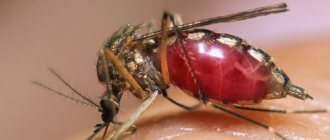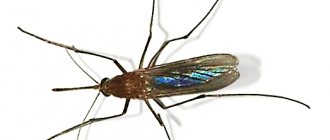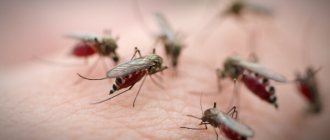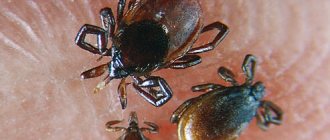According to official statistics, about 2 thousand people fall ill with tick-borne encephalitis in Russia every year. How will tick-borne encephalitis manifest itself this year? Will the average statistical data change or remain within the values of recent years? In which areas of the Moscow region, regions of Russia and countries of the world can encephalitis ticks be found? Is it worth getting vaccinated against the virus in advance and what vaccination schemes can be followed?
What is tick-borne viral encephalitis
Tick-borne encephalitis is a virus that affects the brain and/or spinal cord. If it attacks the brain, it provokes meningitis, the spinal - encephalitis, and both - meningoencephalitis. The virus causes disturbances in the functioning of the nervous system, which can affect both the body and the human psyche. According to the Moscow Department of Health, death of infected people occurs in 25–30% of cases. Full recovery, with timely medical assistance, is also likely.
How is tick-borne encephalitis transmitted?
For dogs
, horses, rodents, birds and livestock, the virus is dangerous in the same way as it is for people. Basically, encephalitis is transmitted directly from a tick at the time of the bite, however, about 20 cases are registered annually in Russia when the virus enters the body along with fresh milk or dairy products. Milk may be contaminated if the cows or goats that gave it were previously infected with encephalitis by ticks. To avoid becoming infected with the virus through fresh milk, it is enough to boil it first.
Endemic territories of Russia for tick-borne encephalitis 2021
Administrative territories where, according to official data, encephalitis ticks are found are called endemic for encephalitis. In Russia, these regions and areas remain basically the same from season to season. You can see the endemic territories for tick-borne viral encephalitis in 2021 on the map.
This map of tick-borne encephalitis clearly displays the overall picture, a complete and most detailed list of endemic territories in Russia
posted on the Rospotrebnadzor website.
There are more ticks in the east than in the west
The degree of danger of contracting tick-borne encephalitis within the main tick habitat increases from west to east. Cases of disease are recorded especially often in the southern regions of the Far East. Most likely, this is due to humid, warm summers and the presence of mixed forests.
The most dangerous regions of the Far East:
- Amur region;
- Sakhalin;
- Khabarovsk region;
- Jewish Autonomous Region;
- Primorsky Krai.
What is characteristic: following warming, ticks move from east to west, and the peak of their numbers and activity in different regions varies throughout the season.
Endemic areas of the Moscow region for tick-borne encephalitis 2020
In the Moscow region, endemic areas are located in the north, there are only two of them - Dmitrovsky and Taldomsky. The remaining areas of the region are considered safe from the point of view of encephalitis, but this does not mean that the ticks living in them are harmless. In addition to encephalitis, parasites can carry:
- Tick-borne rickettsioses
- Human granulocytic anaplasmosis
- Human monocytic ehrlichiosis
- Ixodid tick-borne borreliosis
- Q fever
- Crimean hemorrhagic fever
- Siberian tick typhus
- Tularemia
- Babesioses
Thus, infection with borreliosis statistically occurs 3.5–4 times more often than encephalitis. In 2021, the number of people infected with encephalitis was 1.7 thousand, and borreliosis - 6.5 thousand. For this reason, even if your dacha or other place of planned vacation is located in an encephalitis-safe area, do not neglect protection against ticks.
The absence of encephalitis ticks in certain areas also does not mean that cases of bites are not recorded there. Ticks live and bite wherever there are environmental conditions suitable for them - the presence of vegetation, humidity of about 80% and air temperature of about plus 18–20 ° C. These three factors are present in one way or another in absolutely all areas of the Moscow region, so the risk of being bitten remains everywhere. You can see how far endemic areas are from you and see where ticks are most active in the area on the map.
Incidence of encephalitis by region
If we compare the number of cases in different regions, the picture will also look heterogeneous.
Every year per 100 thousand people fall ill with:
- Up to 4 people in the northwestern federal district (Leningrad, Arkhangelsk regions).
- About 4-10 people in the Tver region and Khabarovsk region.
- Approximately 10-20 people – Khanty-Mansiysk, Tyumen, Omsk and Irkutsk regions.
- About 20-40 people - Chita, Ufa and Sverdlovsk regions.
- Over 40 people – Krasnoyarsk and Altai territories.
In the Far East, endemic areas have existed for hundreds of years, and the situation has not changed for the better. In contrast to this, in the European territory of the country, the number of people sick with tick-borne encephalitis is decreasing from year to year due to the anthropogenic factor (urbanization, land cultivation, landscape changes) and enhanced measures to combat the occurrence of the disease - vaccinations, the use of protective equipment.
Vaccination against tick-borne encephalitis 2021
According to Rospotrebnadzor, last year, as of October 2021, 33,532 people were vaccinated against tick-borne encephalitis in Moscow. Why get vaccinated against the virus and what does it give?
The vaccine forms immunity in the body against the disease, so if you are bitten by a tick infected with the virus, infection and all the ensuing consequences will not occur.
note
This vaccination only protects you from infection with the tick-borne encephalitis virus. It does not affect other pathogens and does not prevent tick bites, so even if you have it done, you still need to be careful and use pest protection while outdoors.
Standard and accelerated encephalitis vaccination schedules
Vaccination against encephalitis can take place according to two schemes - standard or accelerated.
Standard scheme
- 1st vaccination
- 2nd vaccination – 5–7 months after the 1st
- 3rd vaccination – 12 months after the 2nd
- 4th vaccination – every 3 years again
If you start the course in the fall and get the first vaccination in October-November, as Rospotrebnadzor advises, then by the beginning of the summer season you will already have a sufficiently developed immunity to the virus.
Accelerated scheme
- 1st vaccination
- 2nd vaccination – 14 or more days after the 1st
- 3rd vaccination – 12 months after the 2nd
- 4th vaccination – every 3 years again
The accelerated scheme differs from the standard one only at the beginning and is used if you did not manage to start the course on time in the fall. Exactly how much time should pass between the 1st and 2nd vaccinations depends on the age of the person and the vaccine used; your doctor will tell you the exact time interval.
note
With both vaccination schemes, immunity to tick-borne encephalitis begins to develop only after the 2nd vaccination.
To form it at the minimum required level, it is also required that at least 2 weeks pass between the 2nd vaccination and the date of going out into nature, where you may be bitten. Long-term, stable immunity is formed only after the 3rd vaccination, which is given a year after the 2nd. In order to find out whether you have developed immunity to encephalitis, at any stage of vaccination you can independently donate blood to analyze the presence and concentration of antibodies to the virus.
Where can I get vaccinated against encephalitis?
Vaccination against tick-borne encephalitis in 2021 can be done either in a clinic, at the place of attachment, or in any commercial clinic on a paid basis. Before getting vaccinated, be sure to consult with your general practitioner and find out if you have any contraindications for administering the vaccine.
What are the differences between vaccines?
Vaccinations against tick-borne encephalitis are made with Russian or imported vaccines. They all eventually develop equally strong immunity to the virus. The exact timing of the entire course of vaccinations, the volume and likelihood of side effects depend on which vaccine is used. In addition, different vaccines have different minimum age thresholds at which they can be used. If you go to the clinic for a free vaccination, you will be given the vaccine that is currently available to doctors. By receiving the service on a paid basis, you can choose the vaccine yourself.
All information about vaccinations against tick-borne encephalitis is provided here for your information. You can only get accurate individual recommendations from a doctor.
Where did ticks come from?
- Published in No. 109 of 06/21/2016
According to the regional Rospotrebnadzor, since the beginning of the season, more than 19 thousand Sverdlovsk residents have been attacked by ticks. This is 13 percent below the same period in 2015 and 25 percent below the long-term average. With a preliminary diagnosis of tick-borne viral encephalitis, 153 people were hospitalized, but only ten of them had the diagnosis confirmed. There were 209 people diagnosed with tick-borne ixodic borreliosis, and in 56 of them it was confirmed. It turns out that the danger of ticks is greatly exaggerated - when bitten, the risk of contracting tick-borne encephalitis is 0.05 percent, and tick-borne borreliosis is 0.29 percent. For a region with a population of 4.5 million people, these numbers are not so scary.
A comment
Evgenia Katasonova, head of emergency room No. 2 of city hospital No. 36 of Yekaterinburg:
— The peak of tick bites among Sverdlovsk residents occurs in mid-May - mid-June. Now their activity is declining, and in a couple of weeks it will practically stop; until the end of the summer there will be only isolated requests. Moreover, most of the victims were not vaccinated in advance. The number of people bitten in recent years has been approximately the same; there have been no sharp spikes.
Doctor of Biological Sciences Natalia Shashina (Moscow) answered OG’s questions about where ticks came from in Russia and how to fight them
— Natalia Igorevna, where did ticks come from in Russia?
— Scientists agree that they have always lived here and gradually evolved, like other animals. It’s just that their impact was not known before; people got sick in villages, but no one knew why. Only in 1937–1938, when soldiers in military units in the Far East began to fall ill en masse, doctors discovered that ticks carried the tick-borne encephalitis virus.
— Does climate affect their distribution?
— It has an impact, both global and local. In addition, social factors also influence. For example, at the end of the last century, more people started farming around cities, and ticks moved into the suburbs and cities. Due to global warming, ticks are gradually moving north. And the taiga tick, which is widespread in the Sverdlovsk region, is now moving slightly to the west and is pushing out the European forest tick. In the area of Moscow and the Leningrad region, both of these species overlap, but they get along well, are similar in appearance and carry the same infections - tick-borne encephalitis and tick-borne borreliosis.
- But you can’t say that after a while they will completely leave some territory?
- No, they won’t disappear completely. In the process of evolution, they have adapted to even the harshest climates. Ticks are very fertile; they feed on the blood of many animals - birds, livestock, mice, and so on. It is impossible to deprive them of “objects” of food. Ticks have always been and will be, we must learn to live with them.
— Does treating forests and parks help?
- It helps, but only for a short time. In the 1980s, the pesticide DDT was widely used. Later it was banned due to its high accumulative properties - this poison accumulated in the environment for several years. I believe that it should not have been banned everywhere, in agriculture - yes, but to protect against ticks it should still have been left. But its production has stopped, so now compounds with a very short period of action have to be used to treat parks. After a month, they already disintegrate and do not “hit” ticks. In addition, there are no poisons that would act only on ticks and leave other organisms untouched, so they must be used with caution.
— Has medicine learned to cope with the consequences of tick bites?
— Tick-borne viral encephalitis is a serious infection that can lead to disability or even death. However, there is a vaccine for it, and doctors can treat encephalitis if the diagnosis is made on time. Therefore, if you live in an area where ticks are found and are in the forest, then it is advisable for you to get vaccinated. There are no vaccines for other infections that ticks can infect, but they are more easily tolerated by humans.
By the way
Last week, the Rospotrebnadzor office for the Sverdlovsk region announced that visiting the Oleniy Ruchi natural park is dangerous to health because it was not treated against ticks.
In April-May 2021, specialists caught up to 40 ticks within one kilometer of this park. However, according to the law on specially protected natural areas, “Oleniy Ruchi” should not be treated with any pesticides. “The tick is a member of the general ecosystem, which we must preserve safe and sound,” Sergei Smolnikov, chief engineer of the Oleniy Ruchi Park, told OG. — We carry out processing only on the territory of children's camps. Visitors are warned that ticks live in the rest of the territory; notices are posted everywhere. In addition, to cultivate 12 thousand hectares of forest, we need half the district budget; no one will allocate that kind of money to us.











